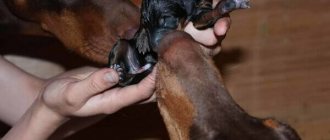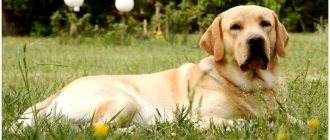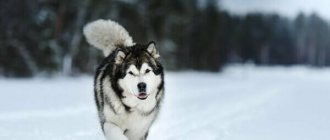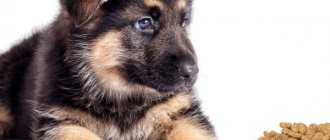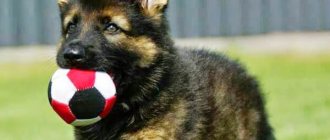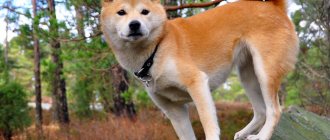The Doberman is a strong and elegant dog with well-developed muscles.
It is not characterized by rudeness and massiveness.
The dog is active, mobile, selflessly devoted to its owner.
This is an excellent guard and pet.
Dobermans are classified as large breed dogs, with an average height at the withers of 63-72 cm and weight of 35-45 kg.
Photos of what newborns look like
Newborn Doberman puppies are born completely helpless, blind and deaf . Newborn Dobermans have no teeth and do not know how to regulate body heat.
The first two weeks after birth, the puppy's needs are very limited - food, sleep and warmth. Previously, during this period, puppies' ears and tails were docked, but now they often do not dock them.
Newborn puppies have an elastic, dense body, large paws and heads.
At one month the puppy's weight is already 3.5-4 kg, body length 22-27 cm.
Development by day in the first month (table)
| Days | Development |
| 1-4 | At this time, the puppy is absolutely helpless, blind, deaf and needs constant care. At the moment he only knows how to suck and crawl on the kug. |
| 5 | The baby is actively gaining weight and growing in height. |
| 6-8 | There is more active weight gain. |
| 8-9 | By this period, the puppy’s weight doubles. |
| 10-15 | The baby's eyes open. |
| 16-18 | The ears open and thermoregulation begins to improve. |
| 19-21 | The Doberman puppy begins to hear and respond to sounds. |
| 22 | The beginning of the appearance of the first teeth |
| 23-24 | The baby can already eat solid food, move independently and play with his brothers and sisters. |
| 25-30 | The little Doberman begins to develop motor activity, thermoregulation is fully formed, and he begins to take an active interest in the world around him. |
Miniature Pinscher Miniature Doberman
Despite the name "dwarf Doberman", the miniature pinscher is not an exact copy of the Doberman in a smaller form. Referring to an independent breed of dogs, they are united with the Doberman by one common ancestor of the smooth-haired pinscher breed. This is where the similarities end. This breed has a second name - miniature pinscher. The Miniature Pinscher is a breed older than the Doberman Pinscher. Its origin dates back to the 15th century.
A born hunter, with sensitive hearing and an excellent sense of smell, he will perfectly cope with the role of a devoted friend in the family and a reliable guard. A smart dog, even as a puppy, will figure out who is prey and who is master and friend, and does not need long and tedious explanations. Hunting instincts are perfectly preserved, even if the animal lives in an urban environment.
At the end of the 19th century, the miniature pinscher standard was determined. An animal with a muscular body, an elongated muzzle and powerful jaws. They have a thin but very strong neck, medium-sized and erect ears. Very proportional dogs, at sexual maturity reaching a height of 25-30 cm at the withers for males, females are a couple of centimeters lower. The weight of an adult dog is 4-6 kg. In males, girls weigh less. Despite its modest size, this is a very strong breed of dog. The coat is smooth, dense, and the color is brown, or less commonly black and tan. The life expectancy of little hunters reaches 15 years.
Puppies grow very smoothly, gradually gaining weight over the months:
| Age: | Weight: |
| 1 month | 0.65 kg |
| 2 months | 1.1 kg |
| 3 months | 1.5 kg |
| 4 months | 1.9 kg |
| 5 months | 2.3 kg |
| 6 months | 2.5 kg |
| 12 months | 4 kg |
How does a puppy develop from 1 to 12 months?
| Puppy age in months. | Description | Puppy weight (male/female) in kg | Puppy height (male/female) in cm |
| 1 | Newborn period. Puppies are completely helpless and completely dependent on their mother. | 3,8-3,5 | 27-22 |
| 2 | At this age, the baby is already able to see, hear, walk, and also tries to eat on his own. In the second month of life, additional complementary foods begin to be introduced. | 8,7-7,8 | 40-33 |
| 3 | This is the period when Doberman babies find new owners. They eat on their own and actively gain height and weight. | 14-12,3 | 49-43 |
| 4 | Transition period. Weight gain will slow down, but at the same time active growth continues. | 18,5-16,5 | 56-50 |
| 5 | At this age, the dog becomes a teenager; its chest and bones are already quite developed. It's time to read the sereno and engage in training. | 22,5-20,3 | 60-55 |
| 6 | The nature of the formation of the psyche. At this age, growth and weight gain stops, character begins to form, and habits are formed. At this age, sexual instincts begin to actively manifest themselves. | 26-23 | 64-58 |
| 7 | The puppy becomes more and more like an adult dog. | 27,8-24,5 | 66-60 |
| 8-9 | The young Doberman is almost an adult, his character is formed, he is active and full of energy. | 31,2-26,6 | 69-64 |
| 10 -12 | By this age, the Doberman becomes an adult dog in need of attention, daily walks and physical activity. | 35-29 | 72-65 |
Briefly about the main thing
- Dobermans are guard dogs that are friendly and loyal to their owners.
- Dogs of this breed are well-oriented and easy to train.
- You can train a Doberman from the age when he came to you and got used to it.
- Choose a quiet place to practice.
- Choose the most delicious treat
- Start your workouts with short sets, doing simple exercises.
- Increase the duration and complexity of training as your puppy ages.
- If you wish, you can take training more seriously by passing the OKD and ZKS tests.
- Try to train your Doberman on positive reinforcement with treats, toys and emotional praise.
To what age do they grow?
At the age of one to two years, the dog actively gains muscle mass, becomes stronger and larger, and may experience a slight increase in height and weight .
The chest may also become slightly larger. Therefore, we can say that Doberman puppies grow up to 2 years of age.
How to care?
Rules to help provide the best care for your pet:
- Start training your puppy from the first day in your home. As early as possible, give him a nickname, show him the place, introduce him to the routine of your family. At first, give your baby as much attention as possible.
- Think about your diet in advance. The diet of a small Doberman must be balanced and include vitamin complexes and necessary supplements. According to experienced dog handlers, the best nutrition is one that combines dry food and natural food.
- From early childhood, accustom your puppy to hygiene procedures, such as bathing, brushing teeth, cutting nails, combing, etc. And remember - such procedures must be regular.
- Daily physical activity is a must for the development of a healthy dog. Daily walks in the fresh air should become the norm for you and your Doberman.
- Take your pet to the veterinarian every year. It will be good if the breeder recommends you a good specialist.
- Once every 4 months, be sure to give your pet anthelmintic drugs for prevention purposes. Treat your dog for ticks once a year.
- Do not protect your pet from communicating with other dogs. Let him get to know his relatives, and at the same time teach himself to behave correctly.
- Be firm in your interactions with your dog; leadership should always be yours.
ZKS - protective guard service
Training in defense is a more serious process than passing the OKD standard. Classes must be conducted with a canine handler. Otherwise, you will turn your dog into an aggressive and uncontrollable animal. ZKS requires a competent and responsible approach to business.
The dog is taught guard qualities, protection, control, and attentive listening to the owner. A properly trained defense dog can save you from intruders. In addition, training in ZKS skills makes the animal much more resilient and confident.
How to feed correctly and how often?
Experienced breeders recommend initially providing the baby with the same nutrition as in the nursery. Ask the breeder what the puppies were fed and give them the same.
After two weeks, gradually introduce new foods into your baby’s diet and monitor his reaction and health..
If your dog has diarrhea, constipation, vomiting, or an allergic reaction, take him to the vet immediately. Perhaps there is an individual intolerance here.
Generally speaking, after three months, a Doberman puppy should eat the same foods as an adult dog. The only difference is that the baby’s growing body needs more vitamins, micro- and macroelements.
The baby should always have access to clean and fresh water.
From the moment the puppy appears in your home until six months, it should be fed at least 6 times a day, then it can be gradually transferred to three meals a day, and then to two meals a day.
The most suitable foods for a Doberman puppy:
- Porridge (rice, buckwheat, oatmeal).
- Boiled meat (veal, chicken, beef).
- Offal (kidneys, liver, tripe, lung).
- Vegetables (cooked and raw).
- Fermented milk products such as yogurt, kefir, fermented baked milk, yogurt, cottage cheese.
What to do if your weight is below normal?
If the puppy’s weight is below normal, first of all, you should understand the reasons.
Possible reasons:
- Weaning from mother . This is a serious test and stress for every puppy. In the first month after weaning and transfer to new owners, the baby may not only stop gaining weight, but even lose it. In order to avoid this, babies are given calcined cottage cheese with yolk and liquid vitamins (dosage should be checked with a veterinarian). If the mixture is thick, dilute it with milk.
- Worms are also a very common cause of weight loss . As a rule, the first time anthelmintic is given to a baby at 2 months of age, but if there is a suspicion of the presence of parasites, then the anthelmintic can be given earlier. Before you start, you need to visit a veterinarian and identify the type of worms. After this, the doctor will prescribe one drug or another, taking into account the age and weight of the baby.
- Nutrition - if the baby is stunted, but does not suffer from any disease, pay attention to his nutrition. Include vitamins, nutritional supplements or vitamin-mineral complexes in your puppy's diet.
First vaccinations
Usually, a puppy's first vaccinations are given at the age of 13-14 weeks . Since it is during this period that the dog’s immune system is formed.
The puppy immediately receives a complex of vaccines against parvovirus enteritis, plague, adenoviral hepatitis, and leptospirosis.
After 21-28 vaccinations are repeated . Then the same procedure is carried out when the dog is one year old.
How to bathe properly?
Bathing stages:
- Before bathing, you should definitely brush the puppy, and since the Doberman's coat is short and smooth, this will not be difficult. This is rather a stage of moral preparation. When combing, talk to your baby, try to set him up in a positive way.
- Preparing a place for swimming. If your puppy is too young, bathing him in a sink or small tub is fine. For an older puppy, bathe it in a regular bath. Place a rubber mat at the bottom of the bathtub or sink to prevent your baby's paws from moving apart. Now fill the bathtub with water. There should not be a lot of water in the bath; bathing should under no circumstances frighten the baby.
- The optimal water temperature is 38-39 degrees (as for bathing a child).
- Choose a special shampoo designed specifically for dogs for bathing.
- Now put your baby in the bath and start washing, rubbing in the shampoo with a soft sponge or cloth. And remember the first bath is always stressful for the dog, try to be as gentle and patient with the puppy as possible. After you finish washing, rinse your dog thoroughly several times. If there is no foam left in the bath, then rinsing can be completed.
- Drying. After you have bathed your baby, wrap him in soft logs and gently dry him, then dry him with a hairdryer.
NOTE!
If your pet behaves well during bathing, be sure to reward him with a treat.
Baby teeth
Dobermans' first teeth grow between 20 and 30 days of life. A full set of baby teeth (32 teeth) appears by 2-3 months.
The first to grow are 4 canines, then 12 incisors, and only after that 12 premolars . Babies have no molars.
Teeth cleaning
When it comes to brushing teeth, as a rule, two questions arise: what should you brush your puppy’s teeth with and how?
In order to clean your pet’s teeth efficiently and not cause harm to him, always use a special brush and toothpaste for dogs..
The most important thing is to accustom the Doberman to this procedure from puppyhood, then later he will tolerate cleaning well and not worry.
If your pet is old enough, then he can sit while brushing. If the puppy is still very small, it is better to place it on the table. Calm the dog down and, if necessary, get help from someone at home.
Start brushing with the furthest teeth, while pulling back the dog's lip.
Then move forward and clean the incisors and canines. Clean the area around the gums thoroughly, as this is where plaque forms.
And remember - you need to brush not only the outside of your teeth, but the inside.
Raising an adult dog
If the moment of raising a Doberman is missed during puppyhood, it will be more difficult to correct the behavior of an adult dog, since it already has certain habits.
Raising an adult dog requires persistence and patience. Of course, you should not yell at your pet or use violence. It is necessary to find an approach that will be applicable specifically to your dog: some need a tougher and stricter owner, while others, on the contrary, need a soft and calm one. Training is carried out individually in connection with the qualities, abilities and character of a particular dog.
How to distinguish a boy from a girl?
To determine the gender of a puppy, simply examine it..
In young male dogs, a little below the navel there will be a small protrusion covered with rolls of skin - this is the penis, and in the perineal area you will see thickly growing hair. In the future there will be testicles here.
In girls, you will not find the characteristic protrusion and fur on the tummy. But if you look under the tail, you will see a small seal resembling a loop. This is the genital slit (loop).
How to choose?
Before you go to the kennel, you should decide what kind of puppy you want: a boy or a girl, a flogged pet or a show winner, a guard or a companion.
And based on this, you will be able to navigate your choice.
The first thing you should pay attention to is the parents. At a minimum, they must be well-mannered and obedient, and at a maximum, they must have all the qualities of a service dog.
Particular attention should be paid to the puppy's mother . It is absolutely unacceptable if the bitch is unkempt and looks unhealthy. Also a very bad sign is inappropriate behavior, hysterical barking and lack of response to the owner’s commands.
The third stage is the puppy itself. What should it be like? Healthy, well-groomed, active, vaccinated.
Signs of a healthy puppy:
- Shiny wool.
- Strong bones.
- Activity and curiosity.
- Clean eyes (there should be no discharge from them).
- Smooth, confident gait, the baby should not limp.
- Melting bite.
- Puppies should be moderately well-fed, but not overweight.
IMPORTANT!
Pay attention to the conditions of keeping the mother bitch and puppies in the nursery, as well as what the breeder feeds them.
Don’t rush into purchasing; go to several nurseries so you have something to compare with.
OKD – general training course
Receiving the OKD standard will indicate that your dog has been trained in basic training skills and is well-mannered and safe for others. To pass the test, you must attend training courses or prepare yourself.
The OKD standard is not mandatory for execution. If the owner is interested in passing the OKD or any training organizations require a certificate of passing this standard, it is necessary to pass the test. Training and compliance with the OKD standard is a simple process, since the criteria are quite simple and loyal to more serious sports.
